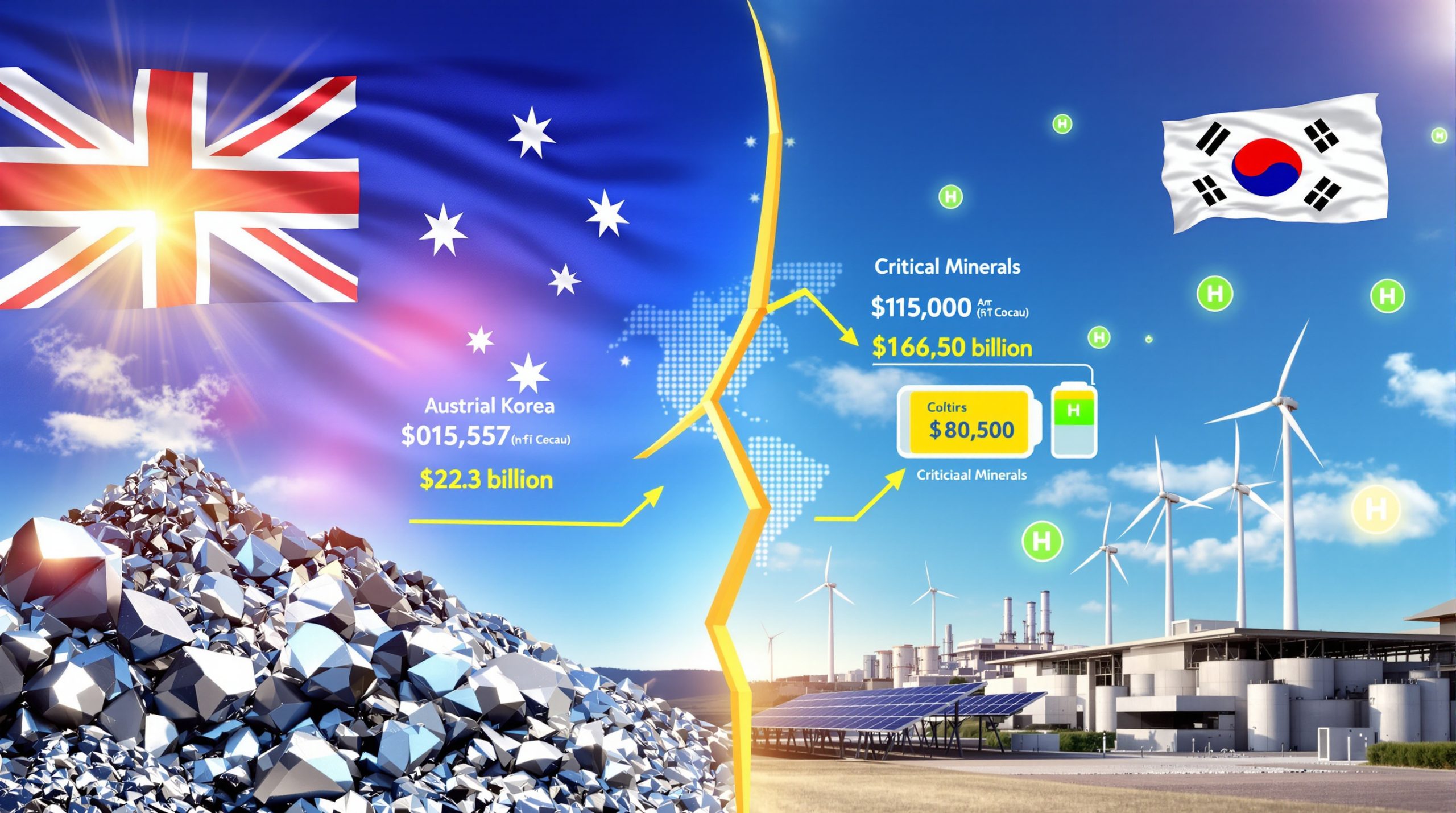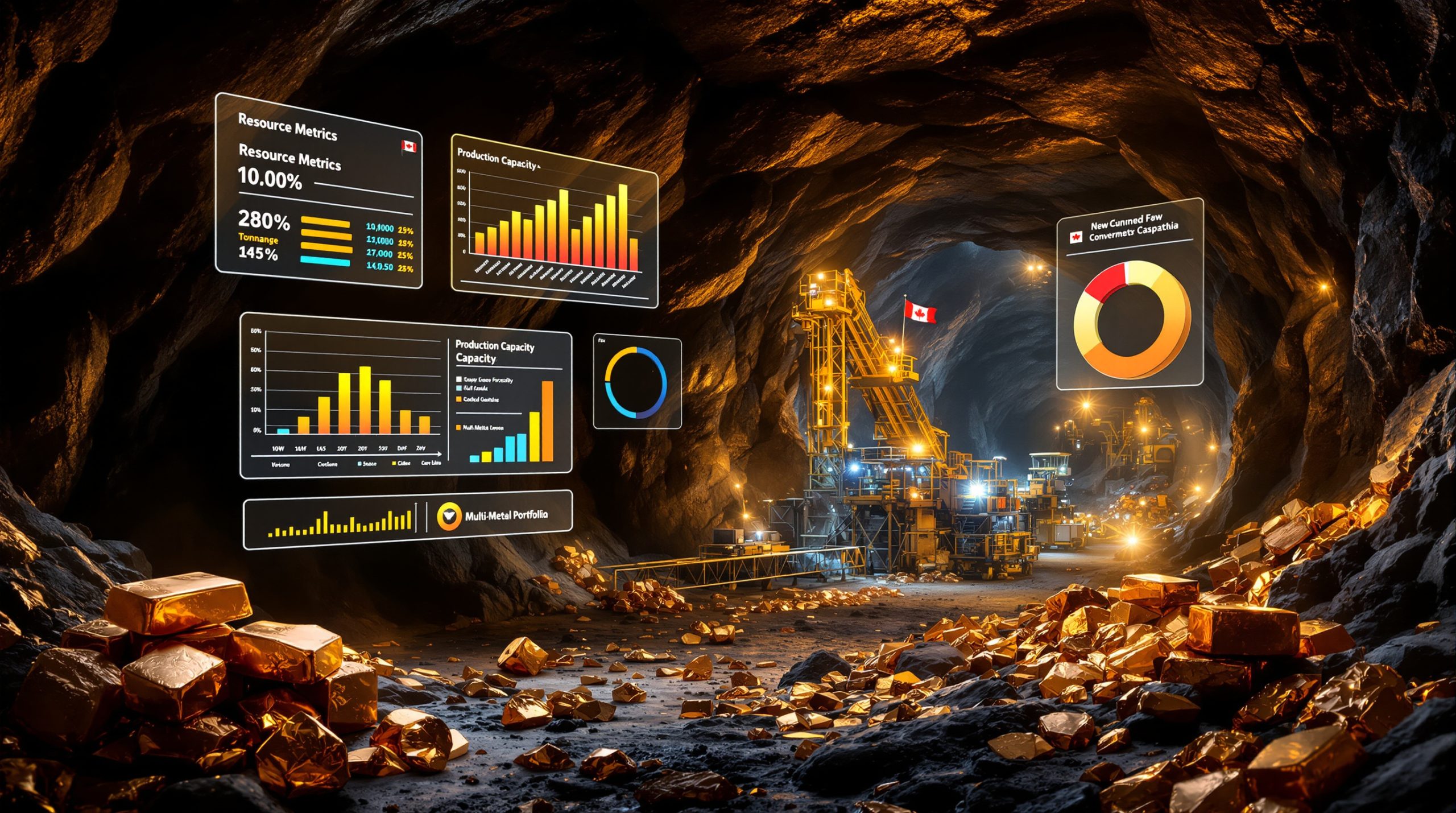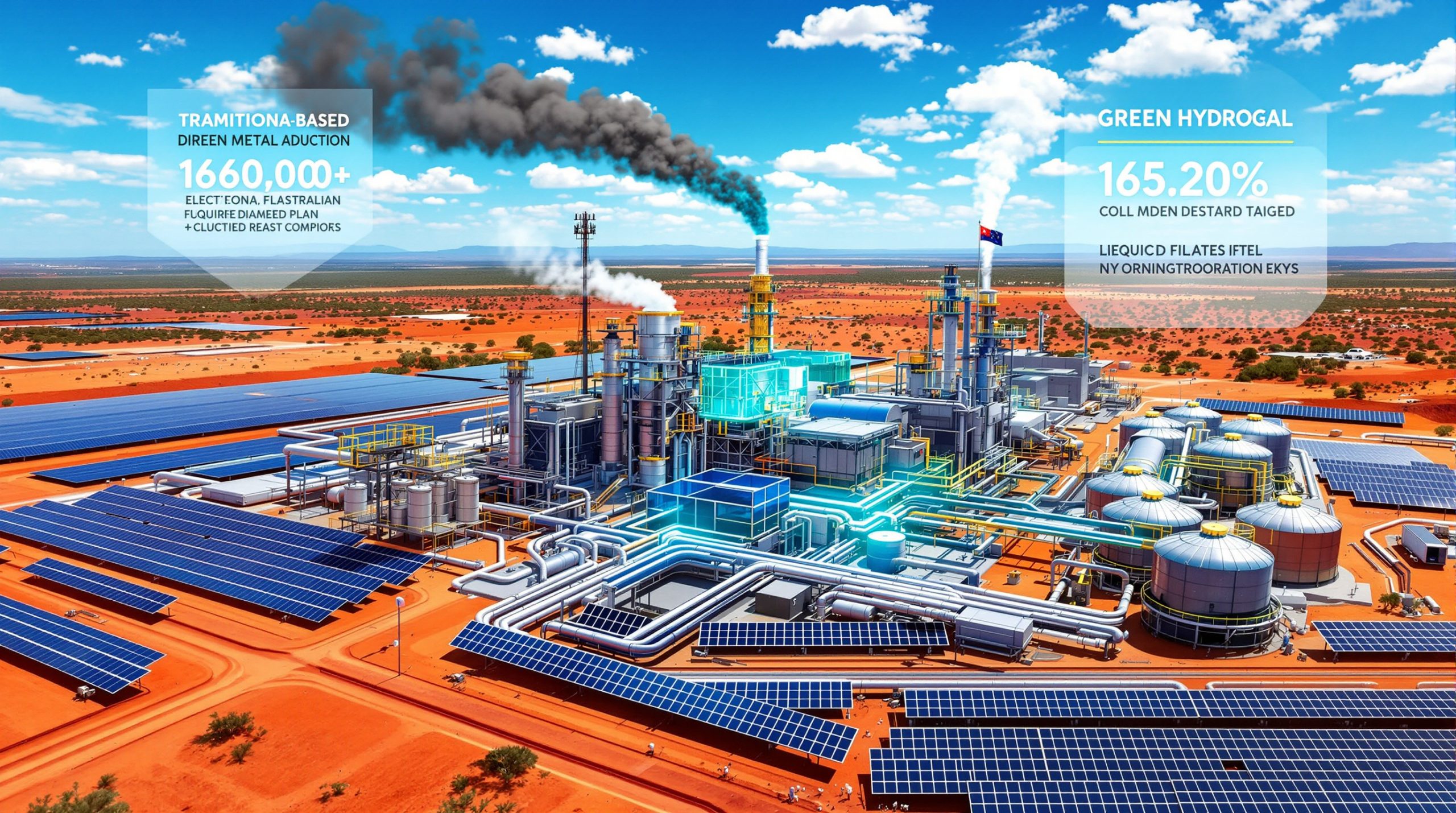Understanding Korea's Strategic Energy Pivot
Global energy markets face unprecedented transformation as major economies accelerate their transition from fossil fuels to renewable alternatives. This shift represents more than environmental policy, it fundamentally reshapes international trade relationships, supply chain dependencies, and economic partnerships that have defined industrial commerce for decades. When examining these transitions through an investment lens, the most compelling opportunities often emerge at the intersection of one nation's phase-out and another's comparative advantages in emerging sectors.
South Korea's commitment to eliminate coal-fired power generation creates a paradigmatic case study in how energy transitions generate cascading economic effects across international partnerships. The strategic implications extend far beyond power generation, influencing everything from critical mineral demand to bilateral trade agreements that could redefine Australia's export economy over the next two decades. Therefore, the question of will South Korea's coal phase out open new opportunities for Australia becomes increasingly relevant for investors and policymakers alike.
What Does South Korea's Coal Phase-Out Timeline Mean for Global Energy Markets?
Understanding the 15-Year Transition Window
South Korea's announcement at the COP30 climate summit established a definitive timeline for coal plant closures, with 40 coal-fired power plants scheduled for decommissioning by 2040. This represents approximately two-thirds of the nation's current coal-fired capacity, creating substantial implications for global thermal coal markets and energy infrastructure planning.
The staged approach reflects sophisticated energy security calculations rather than immediate disruption. By joining the Powering Past Coal Alliance, South Korea commits to accelerating clean energy transitions while maintaining grid stability throughout the 15-year implementation period. Climate Minister Kim Sung-hwan's framework positions this transition as economically advantageous, emphasizing energy security enhancement and industrial competitiveness rather than purely environmental compliance.
Key implementation milestones include:
- 2025-2030: Initial coal plant closures targeting oldest and least efficient facilities
- 2030-2035: Accelerated decommissioning of mid-tier capacity plants
- 2035-2040: Final phase-out of remaining high-capacity installations
- Post-2040: Evaluation of approximately 20 remaining plants through public consultation processes
South Korea's Energy Security Calculations
The replacement energy strategy relies heavily on nuclear power expansion and renewable energy infrastructure development. South Korea currently operates 24 nuclear reactors generating approximately 27% of total electricity supply, with planned capacity additions targeting 35-40% nuclear generation by 2040.
Renewable energy targets complement nuclear baseload capacity through:
| Energy Source | Current Capacity | 2040 Target |
|---|---|---|
| Nuclear Power | 24.7 GW | 35-40 GW |
| Solar PV | 15.8 GW | 45-50 GW |
| Offshore Wind | 1.2 GW | 25-30 GW |
| Onshore Wind | 1.8 GW | 8-10 GW |
This transition fundamentally alters South Korea's import dependency profile. Rather than importing thermal coal from Australia, Indonesia, and Russia, the nation requires critical minerals for battery storage, rare earths for wind turbines, and processed materials for solar panel manufacturing. Consequently, Australia's critical minerals strategy becomes increasingly vital for capitalising on these emerging opportunities.
Which Australian Industries Stand to Benefit Most from Korea's Green Transition?
Battery Supply Chain Opportunities
South Korean EV manufacturers, including Hyundai and Kia, produced approximately 1.2 million electric vehicles in 2024, with production targets increasing to 1.5-1.7 million units annually by 2030. This manufacturing scale creates substantial demand for battery-grade materials that Australia possesses in globally significant quantities.
Critical mineral demand projections for Korean EV manufacturing:
- Lithium: Each EV battery contains 8-10 kg of lithium carbonate equivalent, translating to 8,000-15,000 tonnes LCE annual demand by 2030
- Nickel: Battery production requires 3-7 kg per battery pack, creating demand for 4,500-11,900 tonnes of Class 1 nickel annually
- Cobalt: With 0.5-1.5 kg per battery, Korean manufacturers require 750-2,550 tonnes of battery-grade cobalt yearly
Australian companies have already established strategic partnerships capturing this demand. POSCO's 30% acquisition of Mineral Resources' lithium business represents one of the largest Korean investments in Australian critical minerals, securing feedstock for battery manufacturing while enabling processing capacity development. Furthermore, lithium industry innovations continue to enhance Australia's competitive position in the global supply chain.
Major Korean investment examples include:
- Queensland Pacific Metals: LGES and POSCO hold major shareholdings, with binding offtake agreements for nickel and cobalt production
- Pilbara Minerals-POSCO joint venture: 82% POSCO, 18% Pilbara ownership of South Korean lithium hydroxide processing facility
- Arafura Rare Earths: Binding offtake agreement with Hyundai Motor Company and Kia Corporation for NdPr supply from the Nolans Project
Green Steel and Aluminium Export Potential
South Korea's industrial transition creates opportunity for low-carbon metals exports as Korean manufacturers seek sustainable supply chains for automotive and shipbuilding applications. Australian hydrogen production capabilities position the nation to supply both direct reduced iron and hydrogen-based steel production inputs.
Processing capacity requirements extend beyond raw material extraction. Battery-grade lithium processing currently produces 80,000-100,000 tonnes LCE annually in Australia, requiring expansion to 150,000-200,000 tonnes LCE by 2030 to meet Korean demand projections alone. In addition, the development of a strategic critical minerals reserve could enhance supply security for Korean partners.
How Significant is the $2.3 Billion Coal Export Impact on Australia?
Quantifying the Economic Exposure
South Korea represents Australia's third-largest thermal coal export market, generating $2.3 billion in annual export revenue. This exposure represents approximately 4-5% of total Australian coal export value, though the regional concentration creates more acute economic impacts in coal-dependent communities.
| Economic Metric | Current Impact | 2040 Projection |
|---|---|---|
| Annual export revenue | $2.3 billion | $0-500 million |
| Direct employment | 8,000-12,000 jobs | TBD based on transition |
| Regional economic multiplier | 2.5x direct impact | Dependent on diversification |
| Infrastructure utilisation | Coal rail/port capacity | Requires repurposing strategy |
Employment impact analysis reveals:
- Hunter Valley (NSW): 8,000-10,000 direct coal mining jobs, generating $1.2-1.5 billion regional economic contribution
- Queensland coal regions: 12,000-14,000 thermal and coking coal workers, with South Korea representing significant thermal coal demand
- Port operations: Newcastle and Queensland export terminals employ approximately 3,000-4,000 workers in coal logistics
Regional Economic Diversification Strategies
The 15-year transition timeline provides opportunity for planned economic adaptation rather than sudden disruption. Australian coal regions have initiated transition planning incorporating skills development programmes, alternative industry attraction, and infrastructure repurposing for renewable energy applications.
Critical consideration: The staged coal plant closures create gradual demand decline, allowing regional economies time to develop alternative industries while existing coal operations maintain partial employment through the transition period.
Queensland's Central Queensland coalfields have established transition frameworks targeting critical minerals processing, renewable energy manufacturing, and hydrogen production as replacement industries. These sectors leverage existing industrial infrastructure while creating opportunities for coal workers to transfer skills to emerging energy sectors. However, will South Korea's coal phase out open new opportunities for Australia ultimately depends on successful implementation of these transition strategies.
What Strategic Partnerships Already Position Australia for This Transition?
Existing Critical Minerals Cooperation Frameworks
The 2020 Critical Minerals Supply Chain Cooperation MoU and Low and Zero Emissions Technology Partnership provide established frameworks for expanding bilateral cooperation beyond traditional coal trade. These agreements facilitate Korean investment in Australian processing capacity while ensuring supply chain security for Korean manufacturers.
Partnership outcomes include:
- Government-to-government cooperation: Technical expertise sharing for mineral processing development
- Investment facilitation: Streamlined approval processes for Korean mining investments
- Technology transfer: Joint development of battery material processing technologies
- Skills development: Worker exchange programmes for critical minerals sector training
Major Korean Investment Patterns in Australian Mining
Korean conglomerates have demonstrated systematic investment in Australian critical minerals across the entire value chain, from exploration through processing and manufacturing. This vertical integration strategy secures supply chains while capturing value-added processing margins.
POSCO's integrated approach exemplifies this strategy:
- Upstream investment: 30% stake in Mineral Resources lithium business
- Processing capacity: 82% ownership of lithium hydroxide facility
- Customer integration: Direct supply agreements with Hyundai, Kia battery manufacturers
- Technology development: Joint research on battery recycling capabilities
LG Energy Solution's supply chain model includes:
- Raw material security: Major shareholding in Queensland Pacific Metals
- Processing integration: Nickel and cobalt refining capacity development
- Customer proximity: Battery manufacturing facilities serving Korean automotive sector
Moreover, the emerging battery recycling breakthrough technologies could further strengthen these partnerships by creating circular economy opportunities within the bilateral relationship.
Can Australia Offset Coal Revenue Losses Through Clean Energy Exports?
Revenue Replacement Timeline Analysis
Critical minerals price projections suggest potential revenue replacement within a 10-15 year timeline, though this requires substantial processing capacity investment and infrastructure development. Battery-grade lithium carbonate currently trades at $12,000-15,000 per tonne, compared to thermal coal at $80-120 per tonne, indicating superior value potential per unit of production.
Processing capacity development requirements:
- Lithium processing: Expansion from 100,000 to 200,000+ tonnes LCE annually
- Nickel refining: Development of 50,000-75,000 tonnes Class 1 nickel capacity
- Rare earth processing: Establishment of 5,000-8,000 tonnes separated rare earth production
- Battery recycling: End-of-life battery material recovery capabilities
Competitive Positioning Against Other Suppliers
Australia's competitive advantages in critical minerals include geological endowments, processing expertise, political stability, and established trade relationships with major Asian economies. However, competition from Chile (lithium), Indonesia (nickel), and China (rare earth processing) requires strategic positioning.
Australia's strategic advantages:
- Diverse mineral portfolio: Lithium, nickel, cobalt, rare earths in single supply chain
- Processing capability: Established metallurgical expertise and industrial infrastructure
- Geographic proximity: Reduced shipping costs and supply chain complexity to Asian markets
- Regulatory stability: Predictable investment environment and resource governance
The broader context of mining industry innovation supports Australia's competitive positioning through technological advancement and operational efficiency improvements.
What Policy Changes Could Accelerate Australia's Energy Export Transition?
Government Support Mechanisms
Australian government initiatives supporting critical minerals development include the $2 billion Critical Minerals Facility, Modern Manufacturing Initiative, and Northern Australia Infrastructure Facility. These programmes provide concessional financing for processing capacity development and infrastructure investment.
Recommended policy enhancements:
- Accelerated depreciation: Tax incentives for critical minerals processing equipment
- Skills transition programmes: Retraining support for coal workers entering critical minerals sectors
- Infrastructure development: Government co-investment in port, rail, and processing facility upgrades
- Research and development: Funding for battery recycling, direct lithium extraction, and green hydrogen technologies
Regulatory Framework Adaptations
Environmental approval processes for critical minerals projects require streamlined assessment procedures while maintaining environmental standards. Carbon border adjustment preparation helps Australian exporters demonstrate low-carbon production methods, creating competitive advantages in environmentally conscious markets.
Foreign investment facilitation for Korean companies accelerates capacity development through established expertise and technology transfer. This approach leverages Korean manufacturing knowledge while building Australian processing capabilities.
How Do Other Major Coal Importers Factor Into Australia's Strategic Planning?
Japan's Energy Transition Implications
Japan's coal phase-out timeline, while less aggressive than South Korea's, creates additional demand pressure on Australian thermal coal exports. Japanese utilities plan to reduce coal generation from 32% to 19% of total electricity supply by 2030, with further reductions expected through the 2030s.
Technology cooperation opportunities with Japan include:
- Hydrogen supply chains: Australian renewable hydrogen exports for Japanese industrial applications
- Critical minerals processing: Joint development of battery material refining capabilities
- Carbon capture utilisation: Australian coal-to-chemicals projects serving Japanese markets
India and Southeast Asia Demand Projections
While Northeast Asian markets reduce coal consumption, India and Southeast Asian economies maintain thermal coal demand growth through infrastructure development and industrial expansion. This creates opportunity for market diversification strategies that balance declining demand in some regions with growth in others.
Long-term demand projections suggest:
- India: Continued thermal coal imports despite domestic production increases
- Vietnam: Infrastructure development driving energy demand growth
- Indonesia: Domestic coal prioritisation reducing export availability, creating opportunity for Australian suppliers
What Investment Opportunities Emerge from This Energy Transition?
Critical Infrastructure Development Needs
Port facility adaptations require specialised handling equipment for critical minerals exports, including dust suppression systems, contamination prevention measures, and precise loading capabilities for battery-grade materials. Newcastle and Queensland ports need infrastructure upgrades totalling $500 million to $1 billion for critical minerals export capacity.
Processing plant construction requirements include:
- Lithium refineries: $800 million to $1.5 billion per 40,000 tonne LCE facility
- Nickel processing: $1.2 billion to $2 billion per 50,000 tonne Class 1 facility
- Rare earth separation: $400 million to $800 million per integrated processing plant
Technology Innovation and R&D Priorities
Battery recycling capabilities represent high-value opportunities as Korean EV manufacturers require end-of-life battery material recovery. Current battery recycling recovers 90-95% of lithium, nickel, and cobalt content, creating circular economy opportunities worth $2-3 billion annually by 2040.
Direct lithium extraction technologies enable production from lower-grade brines and reduce environmental impact compared to conventional evaporation methods. Australian research institutions collaborate with Korean companies on membrane separation, ion exchange, and selective precipitation technologies.
Strategic Scenarios for Australia's Economic Adaptation
Best-Case Scenario: Successful Energy Export Pivot
Optimal transition outcomes achieve revenue replacement within 10 years through accelerated critical minerals processing development and Korean partnership expansion. This scenario creates 25,000-30,000 new jobs in processing, manufacturing, and support industries while maintaining regional economic stability.
Success factors include:
- Rapid processing capacity development: 3-5 major facilities operational by 2030
- Technology transfer acceleration: Korean expertise enabling Australian manufacturing capability
- Infrastructure investment: Government and private sector co-investment in port, rail, and processing facilities
- Skills transition success: Coal workers successfully retrained for critical minerals sectors
Challenging Scenario: Delayed Transition Execution
Delayed adaptation creates extended coal revenue dependence as alternative industries develop slowly, leaving regional economies vulnerable to declining demand. Infrastructure investment shortfalls limit export capacity while competitors establish market advantages in critical minerals processing.
Risk factors include:
- Regulatory delays: Environmental approval processes slowing critical minerals project development
- Skills shortages: Insufficient technical expertise for advanced processing operations
- Capital constraints: Limited investment in processing capacity leaving Australia as raw material exporter
- Competition pressure: Chile, Indonesia, and other suppliers capturing value-added processing markets
Most Likely Scenario: Gradual Diversification with Mixed Outcomes
Realistic transition outcomes achieve partial revenue replacement through new energy exports while maintaining some coal demand from alternative markets. Regional economic disparities emerge as some communities successfully transition while others face extended adjustment periods.
Expected outcomes:
- 60-70% revenue replacement by 2040 through critical minerals exports
- Regional variation: Hunter Valley and some Queensland regions successfully diversify, others struggle
- Market diversification: Continued coal exports to India and Southeast Asia partially offset Northeast Asian demand decline
- Technology development: Australian processing capabilities improve but remain secondary to raw material exports
Investment consideration: The gradual diversification scenario suggests portfolio approaches balancing traditional coal investments with emerging critical minerals opportunities, recognising that transition timelines vary by region and commodity.
Navigating Australia's Energy Export Evolution
South Korea's coal phase-out commitment catalyses fundamental changes in Australian export strategy that extend far beyond bilateral trade statistics. The $2.3 billion annual coal export exposure represents both challenge and opportunity, requiring strategic adaptation across mining, processing, and manufacturing sectors. Ultimately, will South Korea's coal phase out open new opportunities for Australia depends on proactive policy support and industry transformation.
The established partnership frameworks through the Critical Minerals Supply Chain Cooperation MoU and Korean company investments in Australian operations provide foundations for successful transition. However, realising this potential requires coordinated policy support, infrastructure development, and skills transition programmes that match the 15-year timeline of South Korea's coal phase-out.
Critical success factors include:
- Processing capacity expansion to capture value-added manufacturing margins
- Technology partnership development with Korean companies for advanced battery material production
- Regional economic diversification strategies that leverage existing industrial infrastructure
- Skills transition programmes enabling coal workers to access critical minerals sector opportunities
The strategic imperative involves positioning Australia not merely as a raw material supplier, but as an integrated critical minerals processor and manufacturer serving Northeast Asian clean energy supply chains. This transition, while challenging, offers pathways to higher-value exports and enhanced economic resilience in the global energy transition.
Disclaimer: This analysis involves projections and assumptions about future market conditions, government policies, and technological developments that may vary significantly from actual outcomes. Investors should conduct independent research and consider multiple scenarios when making investment decisions related to energy transition sectors.
Could Critical Mineral Investments Outperform Traditional Coal Plays?
Discovery Alert's proprietary Discovery IQ model delivers real-time alerts on significant ASX mineral discoveries, transforming complex mining data into actionable investment insights for critical minerals and energy transition opportunities. Explore why major mineral discoveries can generate substantial returns by visiting Discovery Alert's dedicated discoveries page, showcasing historic examples of exceptional outcomes, and begin your 30-day free trial today to position yourself ahead of the market.




